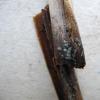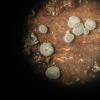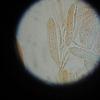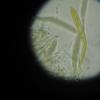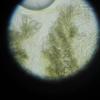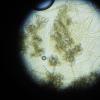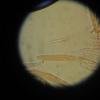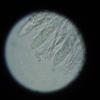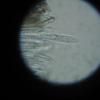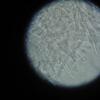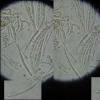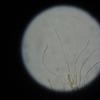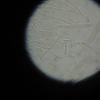
31-12-2025 19:27
Collected from loamy soil, at waterside (completel

30-12-2025 16:44
Pascal DucosBonjour,Une anamorphe rose stipitée, très nombre

30-12-2025 17:14
 Bernard CLESSE
Bernard CLESSE
Bonjour à toutes et tous,Pourriez-vous aider Albe

29-12-2025 10:15
Hulda Caroline HolteHello, I found and collected this propoloid ascom

30-12-2025 09:04
Hello.A Pyrenomycete sprouting sparsely but very d

29-12-2025 17:44
Isabelle CharissouBonjour,J'aimerais savoir si d'autres personnes au

12-11-2021 00:03
Lepista ZacariasHi everybody,A week ago in my fiels trip I noticed
Niptera ?
Michel RIMBAUD,
21-05-2015 10:18
Une récolte dans une zone marécageuse, à la base de grands carex triquètres pourrissants.
Apothécies grises diam. 0,8 mm à marge enroulée et plus claire.
Asques J+ dans Melzer 10-14 x 74-80 µ pas bien mûres donnant peu de spores libres.
Spores pas mûres contenant de nombreuses guttules.
Spore plus mûres sans guttules 2,9-3,2 x 38-51 µ , j'ai deviné 3 septa sur l'une d'elles.
Paraphyses filiformes.
Cellules extérieures piriformes diam 6,4 µ.
Quelques poils (?) cylindriques 2,9 x 50-80 µ (en bas de la photo 5135).
Avec le document www.mollisia.de/Schluessel_englisch.html j'arrive à Niptera filispora.
Qu'en pensez-vous ?
Merci.
Michel
Hans-Otto Baral,
21-05-2015 11:05

Re : Niptera ?
Yes, it seems to be Mollisia filispora. Did you test MLZ after KOH? because M. filispora should react pure red in IKI (Lugol), consequently negative in MLZ, if not KOH-pretreated. If you get a cler blue without KOH then I refrain from this identification.
Michel RIMBAUD,
21-05-2015 18:31
Hans-Otto Baral,
21-05-2015 19:52

Re : Niptera ?
I am not sure with this. Your pics do not show the yellow colour of the iodine. I assume your Lugol has a pale yellow colour which is too diluted. Look at my homepage.
http://www.invivoveritas.de/articles/iodine-reaction/
When you pretreat with KOH you need to wash with water a major part of the KOH away, otherwise the KOH reacts with iodine and discolours it.
http://www.invivoveritas.de/articles/iodine-reaction/
When you pretreat with KOH you need to wash with water a major part of the KOH away, otherwise the KOH reacts with iodine and discolours it.
Michel RIMBAUD,
21-05-2015 22:59
Re : Niptera ?
You are right Zotto, my Lugol is very pale yellow, very paler that Fig 14 in your paper... and I didn't wash KOH before applying Lugol or Melzer.
However after reading your paper attached I compared my pics with Table 1 :
Despite my low concentrated Lugol I always observed a blue apical ring, both with Melzer and Lugol prior to KOH.
So can we conclude that species is not an Hemiamyloid species but an Euamyloid one ?
And in that case what other species than M.filispora could il be ?
However after reading your paper attached I compared my pics with Table 1 :
Despite my low concentrated Lugol I always observed a blue apical ring, both with Melzer and Lugol prior to KOH.
So can we conclude that species is not an Hemiamyloid species but an Euamyloid one ?
And in that case what other species than M.filispora could il be ?
Hans-Otto Baral,
22-05-2015 09:12

Re : Niptera ?
M. excelsior would be blue, but has 7-11-septate spores.
Otherwise I have no images here in my files that apporach this.
You don't have the fungus fresh and could make photos in water? The VBs should be seen in the paraphyses, and the original oil drop pattern in the spores.
Also whether KOH provokes a yellow reaction to the VBs would be valuable to know.
Otherwise I have no images here in my files that apporach this.
You don't have the fungus fresh and could make photos in water? The VBs should be seen in the paraphyses, and the original oil drop pattern in the spores.
Also whether KOH provokes a yellow reaction to the VBs would be valuable to know.
Michel RIMBAUD,
22-05-2015 13:49
Re : Niptera ?
Hi Zotto,
M.excelsior seems a good suggestion, and the shape and dimensions of the spores I have fits well with the biblio (Dennis in particular).
I got new material this morning and new micros in water, and I have some restrictions :
I didn't see clearly the number of septa, I hesitate between septa and limits of guttules, included those inside the asci.
I didn't see enflated paraphysis, they are cylindrical.
M.excelsior is said to grow on Phragmites, while my host is a cyperaceae (Carex or Cyperus).
Beside that, in Photo 5192 is not a crozier at the base of the ascus ?
Could it be M.iridis ?
M.excelsior seems a good suggestion, and the shape and dimensions of the spores I have fits well with the biblio (Dennis in particular).
I got new material this morning and new micros in water, and I have some restrictions :
I didn't see clearly the number of septa, I hesitate between septa and limits of guttules, included those inside the asci.
I didn't see enflated paraphysis, they are cylindrical.
M.excelsior is said to grow on Phragmites, while my host is a cyperaceae (Carex or Cyperus).
Beside that, in Photo 5192 is not a crozier at the base of the ascus ?
Could it be M.iridis ?
Hans-Otto Baral,
22-05-2015 16:44

Re : Niptera ?
I am sure your spores are 3-septate which rules out M. excelsior.
But all your spores and paraphyses are dead. How can it be when you picked them up fresh?
Did you apply strong pressure on the cover slip?
Belonopsis iridis is a good suggestion: It would be easily recognized by the absence of VBs (= refractive vacuoles), which are typical of every god Mollisia.
I don't believe in B. iridis because the asci there are characteristic, with a narrowly conical apex, also apos immarginate.
You gave a good hint: The asci might indeed lack croziers, and then it must be Mollisia asteroma which reacts blue in IKI.
But all your spores and paraphyses are dead. How can it be when you picked them up fresh?
Did you apply strong pressure on the cover slip?
Belonopsis iridis is a good suggestion: It would be easily recognized by the absence of VBs (= refractive vacuoles), which are typical of every god Mollisia.
I don't believe in B. iridis because the asci there are characteristic, with a narrowly conical apex, also apos immarginate.
You gave a good hint: The asci might indeed lack croziers, and then it must be Mollisia asteroma which reacts blue in IKI.
Michel RIMBAUD,
22-05-2015 17:09
Re : Niptera ?
First I appology to have forgotten photo 5192, joined here after.
Is the acus really crozier lacking ?
If yes I agree with M.asteroma, following (here under) that section of the document cited in my 1st message. But I have no image of that species to compare ...
92a Sp. (25)30-40 x 3-4 µm, (2)4 cellules, rétrécies aux cloisons, asques 160 µm, ecto-
excipulum brun bistre "Niptera" pilosa
92b Sp. 36-40 x 2,5-3,5 µm, 4 cellules non rétrécies aux cloisons. Asques 80-90 µm
ectoexcipulum ? ochracé (d'après BARAL) „Niptera" filispora
Is the acus really crozier lacking ?
If yes I agree with M.asteroma, following (here under) that section of the document cited in my 1st message. But I have no image of that species to compare ...
92a Sp. (25)30-40 x 3-4 µm, (2)4 cellules, rétrécies aux cloisons, asques 160 µm, ecto-
excipulum brun bistre "Niptera" pilosa
92b Sp. 36-40 x 2,5-3,5 µm, 4 cellules non rétrécies aux cloisons. Asques 80-90 µm
ectoexcipulum ? ochracé (d'après BARAL) „Niptera" filispora
94a Sp. 35-60 x 2,5-4 µm 95
94b Sp. plus petites 96
95a Asques sans crochet, Sp. 37-53 x 3-3,5(4) µm, huile 4,5-5 "Belonium" asteroma
95b Asques avec crochet, Sp. 35-55(60) x 2,2-3 µm, huile 1-2 M. iridis
Thank very much for guiding me all along that subject.
Michel
Hans-Otto Baral,
22-05-2015 17:52

Re : Niptera ?
Yes, clearly withot croziers.
On Cubby I have a folder asteroma with images.
https://www.cubbyusercontent.com/pl/asteroma/_39df933284274528970de9836615df27
The species is in Ellis & Ellis p. 530, also in Aebi 1972: 102.
On Cubby I have a folder asteroma with images.
https://www.cubbyusercontent.com/pl/asteroma/_39df933284274528970de9836615df27
The species is in Ellis & Ellis p. 530, also in Aebi 1972: 102.



